200 chipsets and Optane Ready support
Both the 200 and 100 chipsets support Kaby Lake and Skylake processors. This dual compatibility could create an interesting dilemma for enthusiasts who want to buy a Skylake processor, or all those who are interested in a new Z270 motherboard.
Intel's 200 series portfolio includes the Z270 chipsets for enthusiasts (overclocking is supported), H270 and B250 for mainstream and business boards without overclocking, and the q270 and Q250 business-specific models. These chipsets bring limited improvements built on the functionality of the 100 series.
Realistically, there is hardly any reason to switch if you already own a Z170-based motherboard.
The features of Z170 are also present in the Z270: you get support for dual-channel storage with up to two DIMMs per channel, six SATA III ports (6 Gbps), up to ten USB 3.0 ports and combine a maximum of 14 USB 2.0 and USB 3.0 ports.
Intel has also upgraded the Management Engine (ME) for all chipsets to 11.6. The Z270, H270, and Q270 platforms support 0, 5, and 10 on-board RAIDs, even though the direct media interface (DMI) media interface between the CPU and PCH limits throughput.
| Z270 | Z170 | H270 | H170 | B250 | B150 | Q250 | Q270 | |
|---|---|---|---|---|---|---|---|---|
| Chipset PCIe-3.0-Lanes (up to) |
24 | 20 | 20 | 16 | 12 | 8 | 14 | 24 |
| HSIO Lanes | 30 | 26 | 30 | 22 | 25 | 18 | 27 | 30 |
| Processor PCIe 3.0 Lanes Configuration |
1×16 or 2×8 or 1×8+2×4 | 1×16 or 2×8 or 1×8+2×4 | 1×16 | 1×16 | 1×16 | 1×16 | 1×16 | 1×16 or 2×8 or 1+8+2×4 |
| Dmi | 3.0 | 3.0 | 3.0 | 3.0 | 3.0 | 3.0 | 3.0 | 3.0 |
| SATA 3.0 Ports (6Gb/s, up to) |
6 | 6 | 6 | 6 | 6 | 6 | 6 | 6 |
| USB 3.0 ports | Up to 10 | 10 | 8 | 8 | 6 | 6 | 8 | Up to 10 |
| USB ports total (2.0 + 3.0) |
14 | 14 | 14 | 14 | 12 | 12 | 14 | 14 |
| Intel RST PCIe 3.0 ports |
3 | 3 | 2 | 2 | 1 | 1 | 1 | 3 |
| Overclocking | Yes | Yes | No | No | No | No | No | No |
| Independent Display Support | 3 | 3 | 3 | 2 | 3 | 3 | 3 | 3 |
| Memory (Type) |
DDR4/3L | DDR4/3L | DDR4/3L | DDR4/3L | DDR4/3L | DDR4/3L | DDR4/3L | DDR4/3L |
| Memory (Channels/DPC) |
2/2 | 2/2 | 2/2 | 2/2 | 2/2 | 2/2 | 2/2 | 2/2 |
The PCH acts as a communication center for many core functions—and Intel continues to use the same four-Byte/s fast DMI 3.0 connection between PCH and CPU. After all, Intel adds four PCIe lanes to the Z270, H270, and B250 chipsets.
Motherboard manufacturers also benefit from more HSIO (High Speed I/O) lanes than before, allowing them to realize various features such as additional SATA, Ethernet, USB and M.2 interfaces. For the Z270 boards, their number grows from 26 to 30 lanes, while the increase in H270 from 22 to 30 lanes is significantly larger.
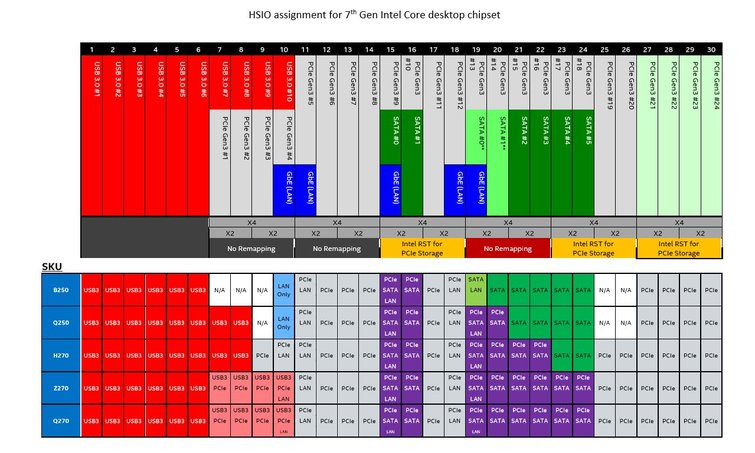
The H-Series chipsets are traditionally slimmed-down versions of the Z models with fewer HSIO lanes and a lack of overclocking support. But the jump from 22 to 30 HSIO lanes will result in a wider variety of placements – for example, more storage and connectivity options.
Intel limited the HSIO lanes to one x4 connection per device for the 100 series chipsets, with the 200 chipsets increasing to x8 per device. This would even include an additional PCIe slot. But here too it should be noted that also an x8 arrangement of the limited DMI 3.0 throughput.
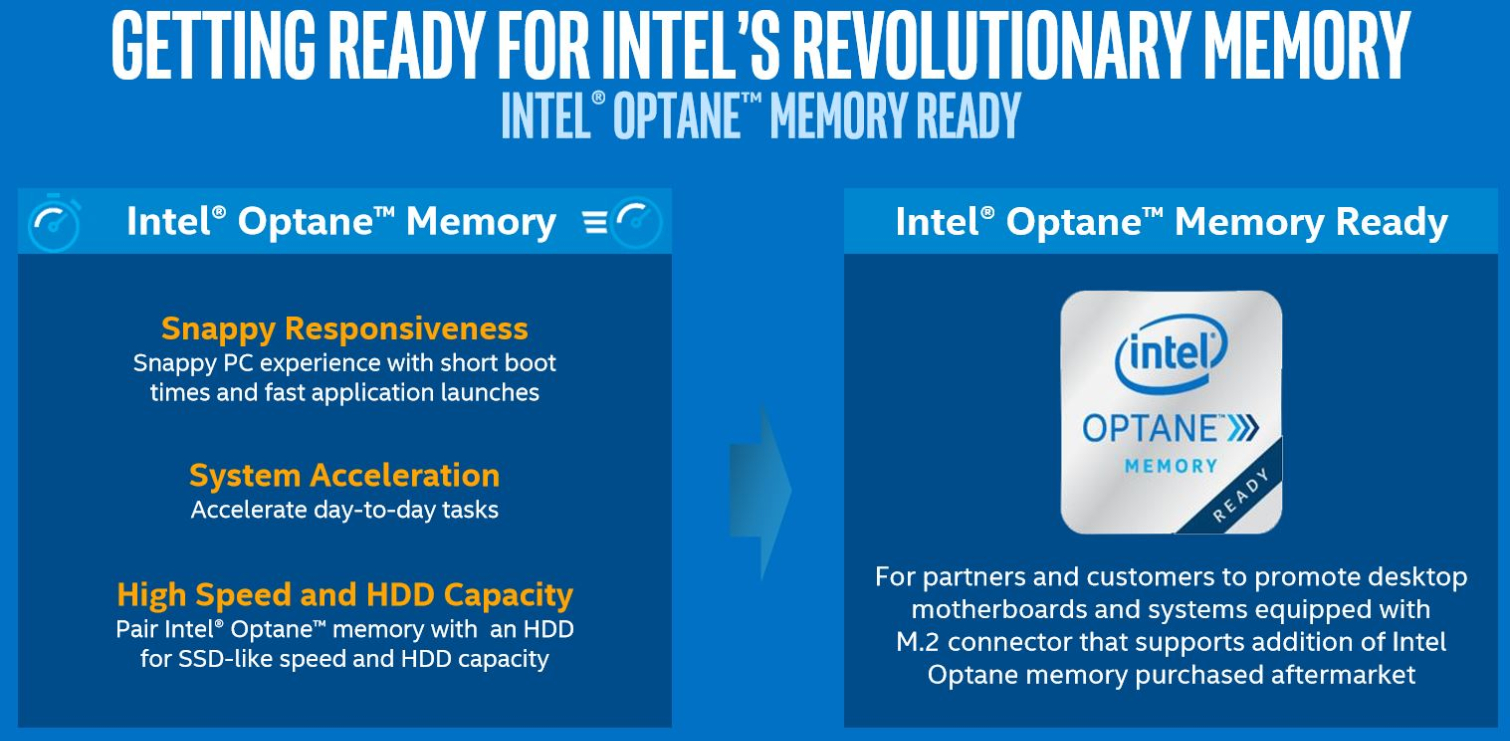
However, Intel's "Optane Memory Ready" branding is unspoken – and while Intel isn't yet ready to address the issue in content, the company is already busy marketing for this feature. "Optane" is Intel's brand name for its 3D Xpoint-based storage products designed to usher in the era of persistent storage.
Optane should rank between NAND and DRAM in terms of price and performance, so it will be much faster than current storage solutions – but also significantly more expensive. Optane should even be fast enough to act as a system memory that is plugged in as a DIMM module. However, Intel seems to have completely put its Optane DIMMs on hold for the time being, so 3D Xpoint storage on the Kaby Lake platform will only debut as a storage cache.
We've also discovered the AIC (Add-in Card) version of an Optane SSD that fits into a normal PCIe slot. However, Intel's documents suggest that the manufacturer will first launch an M.2 variant. The Optane M.2 SSD is expected to become available in the second half of this year as cache storage that speeds up the boot process and application startup. Intel's Rapid Storage Technology (RST) driver will probably be responsible for identifying "hot" data, which is commonly used, and moving it to the Optane NVMe SSD.
But this type of fast cache is nothing new in itself and in the SSD age of much less practical significance than the first SSD caches in the HDD age.
Intel has offered several caching options in the past, none of which have been really well received by enthusiasts – and Optane could do the same for the above reason.
In addition, the bank's cache solutions struggle with latency spikes due to out-of-cache data access—and the frequency of "stuttering" performance correlates directly with the size of the cache. The Optane M.2 SSDs will probably be available in sizes of 16 and 32 gigabytes – so not large enough to use as boot drives. Even for really demanding multitasking environments, this is not enough.
Optane cache SSDs will require a 200-series chipset and a Kaby Lake-based Core i3 processor (or better). So if you switch to a Kaby Lake processor as the owner of a 100 series motherboard, you won't be able to use the cache function. The chipset restriction also implies that fast optane memory is also constrained by limited DMI 3.0 throughput.
BCLK-based voltage adjustment and AVX offset ratio
Intel promotes its BCLK-based voltage clock frequency tool as a handy tool for overclockers, but offers little insight into its specific functionality. According to Intel, however, the software is designed to improve the stability and reliability of overclocking by optimizing the processor's supply voltage based on its BCLK frequency.
Unfortunately, with our locked samples, we had little success with BCLK-based overclocking, so the whole thing could be of quite manageable use. But we stay on the ball.
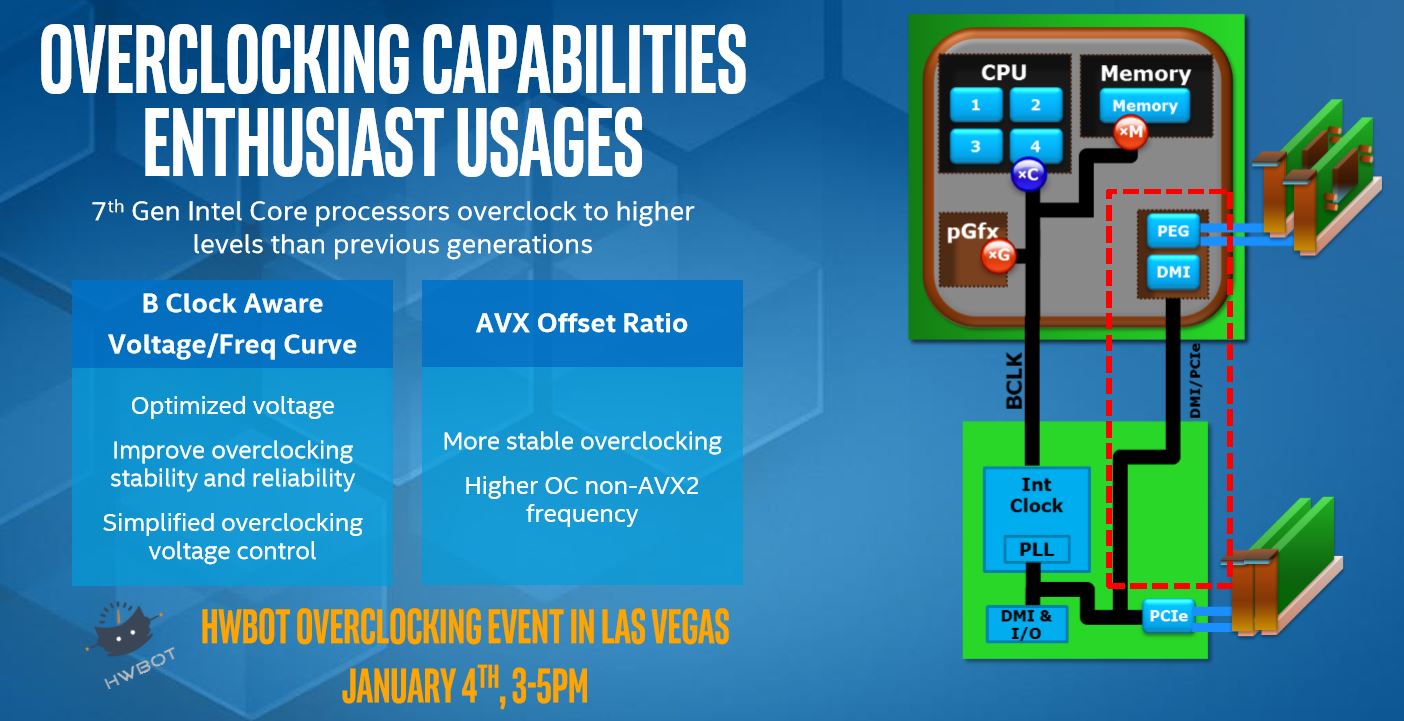
The customizable AVX Offset Ratio (Advanced Vector Extension) was introduced with the Xeon processors as a locked parameter. For The Broadwell E processors, Intel first offered the feature as an unlocked, customizable parameter—and Kaby Lake makes it available for mainstream overclocking.
AVX workloads are true power eaters, generating significantly more waste heat than non-AVX workloads. Thanks to the offset ratio, the processor can slow down the clock frequencies when performing AVX instructions. In return, you can achieve higher overclocking for non-AVX workloads.
With the MSI Z270 Gaming M7, we were able to define an AVX offset ratio and use it together with our manually adjusted Vcore settings.
Intel HD Graphics 630 – Gen9.5 brings 4K
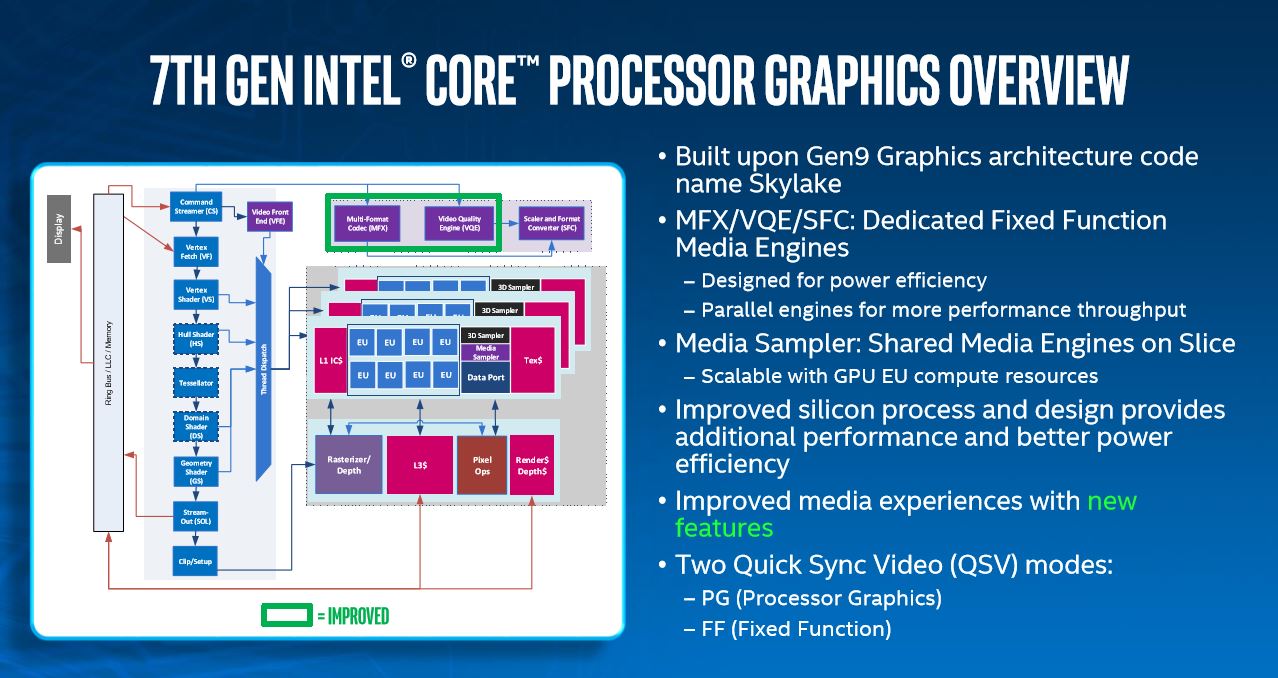 Intel replaced the Gen9 media architecture of the HD Graphics 530 with the Gen9.5 architecture in the HD Graphics 630. The new architecture is similar to the Gen9— the same design with eight EUs per sub-slice (a total of 24 EUs in a GT2 configuration) – and supports all previous features. Intel has also changed the name of its eDRAM-filled offerings from Iris Pro to Iris Plus.
Intel replaced the Gen9 media architecture of the HD Graphics 530 with the Gen9.5 architecture in the HD Graphics 630. The new architecture is similar to the Gen9— the same design with eight EUs per sub-slice (a total of 24 EUs in a GT2 configuration) – and supports all previous features. Intel has also changed the name of its eDRAM-filled offerings from Iris Pro to Iris Plus.
HD Graphics 630 gets the same 350 MHz basic and 1150 MHz dynamic clock, but combines this with revised MFX (decode/encode) and VQE engines. The Multi Format Codex (MFX) engine supports VP8 and AVC codecs as well as HEVC (10 bit decode/encode) and VP9 (8/10 bit decode and 8 bit encode, but not VP9 in 10 bit encode. The VQE engine also enjoys HDR and wide-color gamut support.
The optimized fixed-function hardware eliminates the hybrid CPU/GPU processing strategy of Skylake's Gen9 during HEVC Main10 decode and VP9-8bit decode operations, reducing CPU overhead and associated power consumption. The Gen9.5 engine supports up to eight simultaneous 4Kp30 streams (HEVC and/or AVC) and 4Kp60 HEVC decode operations at 120 MByte/s in real time.
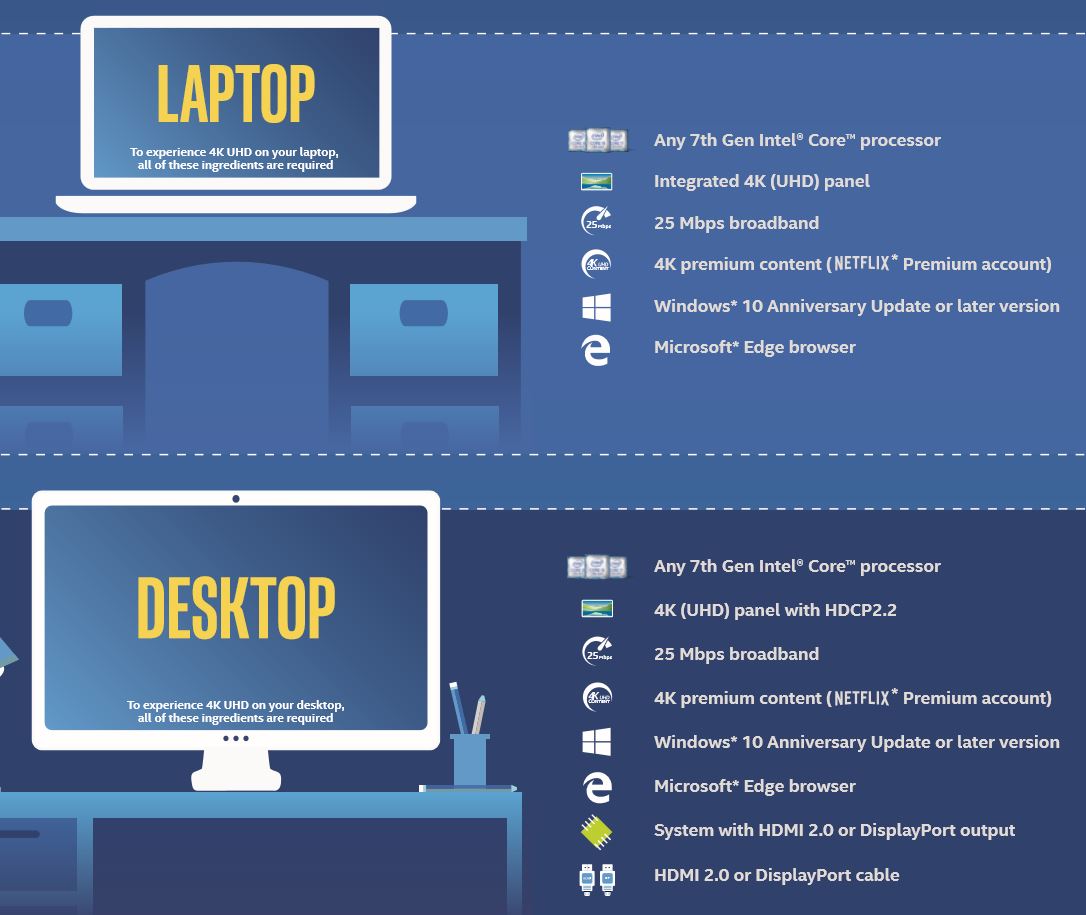 These advances may be great for the mobile sector, but they are likely to add little value to enthusiasts with powerful graphics cards in a desktop setup.
These advances may be great for the mobile sector, but they are likely to add little value to enthusiasts with powerful graphics cards in a desktop setup.
There's also a confusing fact when streaming 4K Netflix content: Netflix requires PlayReady 3.0 DRM and hardware-based 10-bit HEVC decoding, which is currently only possible with Windows 10 and Kaby Lake processors – a sham, who Bad lyses thinks. Skylake and its predecessors do not support 10-bit HEVC decode. Nvidia's 10×0 Series GPUs support both technologies, but they don't yet master 4K streaming.
4K video streaming is still in the baby phase, but annoying DRM and requirements like HDCP 2.2 could be serious limitations. The list of prerequisites – including the Windows 10 Anniversary Update, HDMI 2.0 or DisplayPort – is confusing enough for "whole normal" users that Intel has created an infographic to deal with in the 4K paragraph jungle.
Streaming 4K may be reason enough for some mainstream users to upgrade their desktops, but the narrow offering of content providers is likely to affect fast adaptation here as well. After all, what do you need it now when there are hardly any providers – and future offers probably bring other requirements anyway?
Only suitable for Windows 10 users
Microsoft announced last year that Intel's Kaby Lake and AMD Zen processors would only be fully supported by Windows 10. The company indicated that the drivers of older operating systems, including Windows 7 and 8.1, would not be adapted to the new hardware.
Based on our initial tests, we can confirm that Intel's HD Graphics 630 is not currently working properly on Windows 7 and Windows 8.1. Both operating systems install generic drivers for the display adapter (even after installing the latest drivers and updates), so many core features of the IGP solution are not available. We also experienced stability issues on Windows 7 that could even prevent the use of an external graphics card as a workaround.
This may not be a decisive factor for enthusiasts, who are always lagging behind the latest operating system in terms of software. But the roughly 47 percent of all computer users worldwide who still use Windows 7 (and the eight percent with Windows 8.1) would still have to schedule a Windows 10 update if they were considering a Kaby Lake upgrade.
Microsoft also allows only a limited number of component changes before the OS license becomes invalid, which is worth considering when upgrading an existing system with a 100 series chipset.
It should also be noted that despite the official end of mainstream support for Windows 7 in January 2015 and the free upgrade offer, Microsoft has apparently failed to convince the majority of Windows users to switch to Windows 10. For the unpopular Windows 8/8.1, Microsoft still offers its "mainstream support" until January 2018 – but ultimately this is misleading if the operating system does not support modern processors.
- 1 - Einleitung
- 2 - Z270, Optane, Overclocking-Tools und HD Graphics 630
- 3 - Test-Setup und Overclocking
- 4 - Benchmarks: Rendering und Office
- 5 - Benchmarks: Workstation-Anwendungen
- 6 - Benchmarks: DTP und Multimedia
- 7 - Benchmarks: Gaming und integrierte Grafik (iGP)
- 8 - Core i7-7700K: Leistungsaufnahme & Temperaturen
- 9 - Core i7-7700: Leistungsaufnahme & Temperaturen
- 10 - Core i5-7600K: Leistungsaufnahme & Temperaturen
- 11 - Core i5-7600: Leistungsaufnahme & Temperaturen
- 12 - Unterschiedliche Chipqualität und ihre Folgen
- 13 - Fazit

















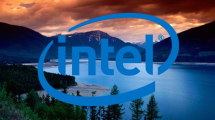
















Kommentieren